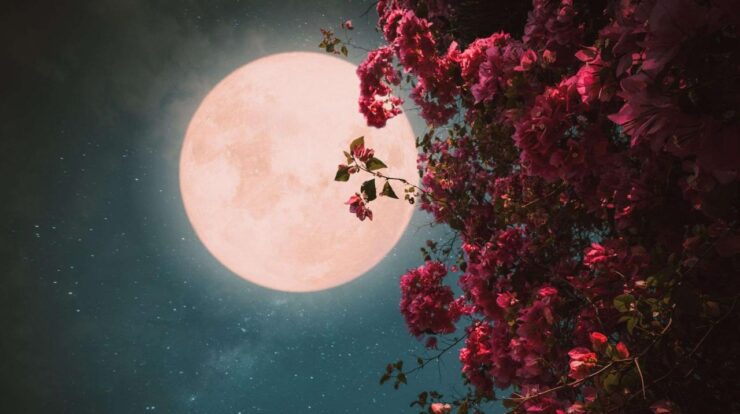
The Pink Moon 2024 is an astronomical phenomenon that will grace the night sky with its enchanting presence. This celestial event holds cultural, scientific, and artistic significance, promising a captivating experience for observers worldwide.
In this comprehensive guide, we delve into the astronomical significance, visual characteristics, observation techniques, and cultural impact of the Pink Moon 2024. Get ready to witness the celestial magic unfold as we explore the depths of this captivating lunar spectacle.
Pink Moon 2024: Astronomical Significance

The Pink Moon, also known as the April Moon, is a celestial phenomenon that occurs annually in April. It is the first full moon after the spring equinox, marking the transition from winter to spring in the Northern Hemisphere. The Pink Moon holds astronomical significance as it signifies the beginning of the agricultural season and serves as a guide for farmers and agriculturalists.
The celestial mechanics behind the Pink Moon’s occurrence in 2024 are relatively straightforward. The full moon phase occurs when the Earth, the Moon, and the Sun are aligned, with the Earth positioned between the Moon and the Sun. During this alignment, the Moon’s entire face is illuminated by sunlight, resulting in the appearance of a full moon.
In 2024, the Pink Moon will reach its peak illumination on April 25th at 11:54 PM UTC.
The Pink Moon has cultural and spiritual associations in various traditions. In Native American cultures, the Pink Moon is associated with the growth of new plants and the renewal of life. In some European traditions, the Pink Moon is believed to bring good luck and prosperity.
Pink Moon 2024: Visual Characteristics
The Pink Moon is known for its unique visual characteristics, which distinguish it from other full moons. Despite its name, the Pink Moon does not appear pink in color. The name is derived from the pinkish hue that is often visible in the eastern sky just after moonrise.
This coloration is caused by the scattering of sunlight by atmospheric particles, known as Rayleigh scattering.
The Pink Moon is typically larger and brighter than other full moons due to its proximity to the Earth. During its peak illumination, the Pink Moon can appear up to 14% larger and 30% brighter than an average full moon.
This increased size and brightness make the Pink Moon a spectacular sight to behold.
Pink Moon 2024: Observation and Photography
Observing the Pink Moon with the naked eye is a rewarding experience. To enhance your viewing, find an open area with minimal light pollution. The Pink Moon will be visible throughout the night, but it is best viewed during moonrise and moonset when it is closest to the horizon.
If you have binoculars or a telescope, you can observe the Pink Moon in greater detail. Look for craters, mountains, and other features on the Moon’s surface. With a telescope, you may even be able to see the faint glow of the Earth’s atmosphere, known as earthshine.
Capturing stunning photographs of the Pink Moon requires careful planning and preparation. Use a tripod to stabilize your camera and avoid blurry images. Set your camera to manual mode and adjust the exposure settings to capture the Moon’s brightness and detail.
Experiment with different compositions to create unique and memorable images of the Pink Moon.
Pink Moon 2024: Impact on Wildlife and Nature
The Pink Moon has a noticeable impact on wildlife and nature. Many nocturnal animals, such as owls, bats, and coyotes, are more active during the Pink Moon’s illumination. The increased brightness provides them with better visibility for hunting and foraging.
The Pink Moon also affects plant growth and seasonal changes. The increased moonlight stimulates plant growth, particularly in spring-flowering plants. The Pink Moon’s light can also influence the timing of bird migrations and the emergence of insects.
Ecologically, the Pink Moon plays a role in maintaining natural ecosystems. The increased illumination provided by the Pink Moon allows animals to navigate and forage more effectively, contributing to the balance and stability of their habitats.
Pink Moon 2024: Cultural and Artistic Inspirations
Throughout history, the Pink Moon has served as a source of inspiration for art, literature, and music. Its unique appearance and cultural significance have captured the imagination of artists and writers alike.
In literature, the Pink Moon has been mentioned in works by poets such as William Wordsworth and Robert Frost. The Pink Moon’s beauty and mystery have inspired countless poems and stories.
In music, the Pink Moon has been the subject of songs by artists such as Nick Drake and Bob Dylan. The Pink Moon’s ethereal glow and evocative nature have provided a rich backdrop for musical compositions.
Epilogue: Pink Moon 2024
As the Pink Moon 2024 draws to a close, we are left with a profound appreciation for its beauty and significance. This celestial event has not only provided a mesmerizing visual spectacle but has also deepened our understanding of the cosmos and our place within it.
Whether observed through scientific lenses or artistic interpretations, the Pink Moon continues to inspire awe and wonder in all who behold it.
Key Questions Answered
When will the Pink Moon 2024 occur?
The Pink Moon 2024 will reach its peak illumination on April 19, 2024.
Why is it called the Pink Moon?
Despite its name, the Pink Moon does not actually appear pink. The moniker originates from the blooming of pink wildflowers in North America during April, the month in which the Pink Moon typically occurs.
Where can I observe the Pink Moon?
The Pink Moon is visible from anywhere on Earth with clear skies and minimal light pollution. Find an open area with a clear view of the eastern horizon.
